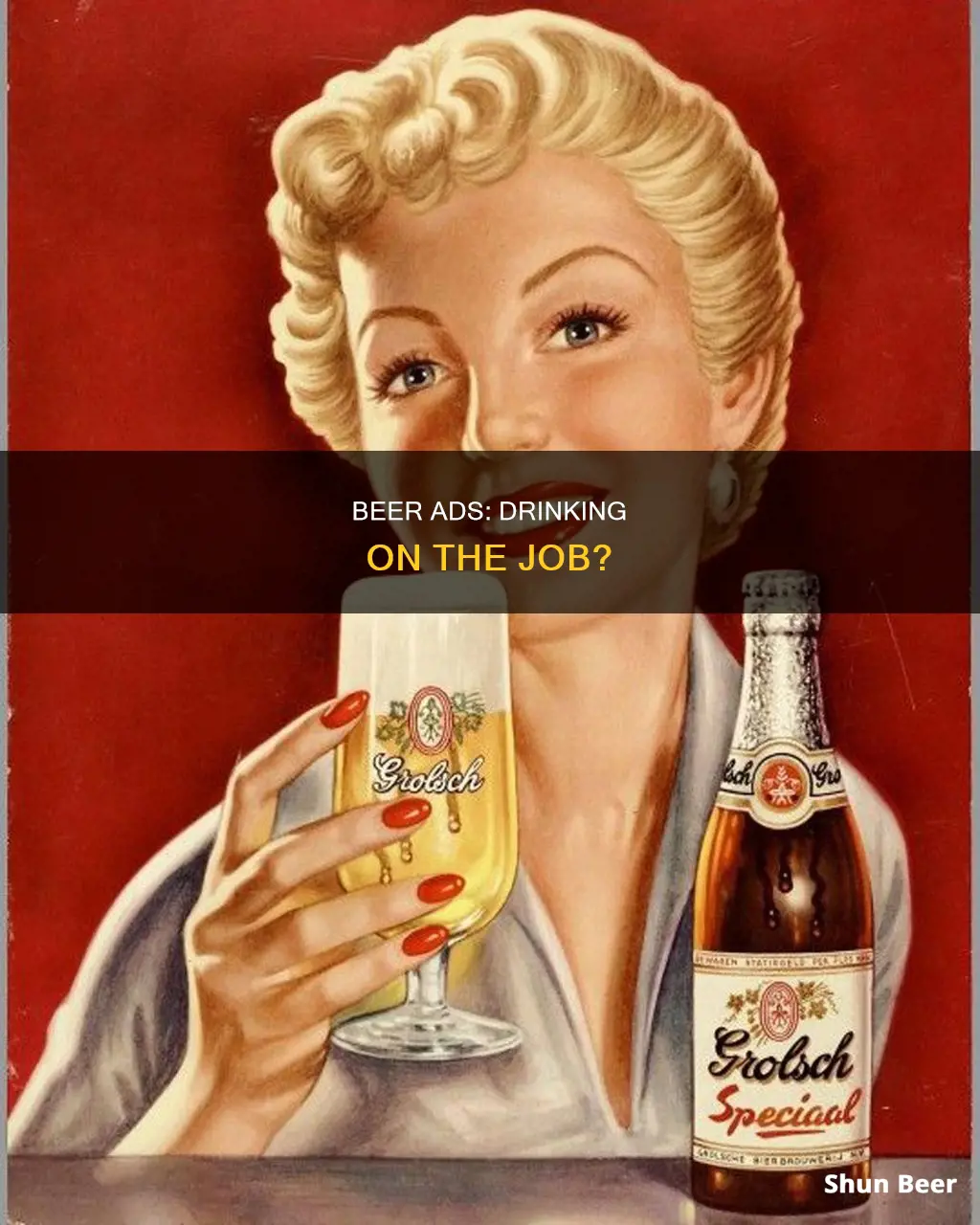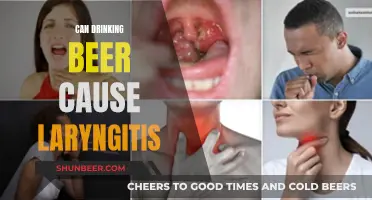
Beer commercials are a common feature of television advertising, but one thing you won't see is someone actually drinking beer. This is due to a long-standing regulation by TV networks, which is not a government rule but is nonetheless effective. The Federal Communications Commission (FCC) has stated that there are no laws prohibiting the broadcast advertising of alcoholic beverages, and the rules are left to the networks. Beer companies must be careful not to stir things up and risk a public cry for a new law, so they tend to be conservative in their advertising. The focus of beer ads is usually on the fun people are having and the enjoyment of sports games, rather than the consumption of the beverage.
| Characteristics | Values |
|---|---|
| Who regulates the depiction of drinking beer in ads? | Television networks, not the government |
| What is the nature of the regulation? | It is a restriction, but not a law |
| What is the rationale behind the regulation? | To discourage underage drinking |
| What are the consequences of violating the regulation? | The ad may not be approved by TV networks |
| Are there any exceptions to the regulation? | Yes, famous athletes, entertainers, and celebrities who are of legal drinking age are exempt from the minimum age requirement of 25 for actors in beer commercials |
What You'll Learn

Beer ads must include specific information about the product
Beer advertisements must include specific information about the product being advertised. In the United States, the marketing and advertising of alcoholic beverages are regulated under the Federal Alcohol Administration Act (FAA) by the Tobacco Tax and Trade Bureau (TTB), which is part of the Department of the Treasury. While the First Amendment allows for freedom of speech, advertisements for alcoholic products must be truthful and without deception. They must also provide enough information about the identity of the product so that consumers can make educated decisions about what the product is and what it contains.
For malt beverages and beer, the following information must be included in the advertisement:
- The class the product belongs to (e.g., ale, stout, lager, etc.)
- The name and address, including the city and state, of the advertiser
- The type, class, and/or distinctive designation that the product belongs to (e.g., red wine, sparkling wine, white wine, champagne, etc.) for wines
In addition to these specific requirements, there are also general prohibited practices for alcoholic advertisements. These include:
- Statements that are misleading, false, or untrue
- Saying something negative or disparaging about a competitor
- Indecent or obscene representations, designs, or statements
- Misrepresenting analyses, standards, or tests
- Guarantees that are misleading, excluding money-back guarantees
- Statements falsely heralding the health benefits of alcohol
- Claims that alcohol is made, sold, or marketed under federal or state regulation
It is worth noting that the TTB does not have to approve ads before they are run or placed. However, they do provide a free voluntary pre-screening service that industry members may use. They also review complaints to ensure that advertisements comply with all rules and regulations.
Furthermore, the Beer Institute, one of the three major alcohol supplier trade associations, has its own voluntary Advertising and Marketing Code. This code includes age requirements for models and actors employed in beer advertising and marketing materials. While models and actors must be a minimum of 25 years old and appear to be of legal drinking age, this provision does not apply to recognisable athletes, entertainers, and other celebrities who are of legal drinking age.
Beer and Abs: Is It Possible to Have Both?
You may want to see also

The First Amendment limits federal regulation of alcohol advertising
The Twenty-first Amendment to the United States Constitution grants each state and territory the power to regulate alcohol within their jurisdiction. This includes the production, sale, distribution, and consumption of alcohol. While the amendment recognises states' rights to regulate or prohibit alcoholic beverages for legitimate purposes, it does not completely remove Congress's power to regulate alcohol under the Commerce Clause. The federal government has continued to tax and regulate alcohol-related activities, including advertising.
In another case, California Retail Liquor Dealers Ass'n v. Midcal Aluminum, Inc., the Supreme Court held that the Sherman Antitrust Act, which prohibits contracts that restrain trade, preempted a California resale price maintenance law for wine. The Court determined that the federal interest in competition and free markets outweighed the state's interest in promoting temperance.
While the First Amendment limits federal regulation of alcohol advertising, it is important to note that states have significant discretion in regulating alcohol within their jurisdictions. The Twenty-first Amendment grants states broad powers in this area, and their regulations may be subject to federal commerce power in specific situations. The balance between state and federal power depends on the specific circumstances of each case.
In terms of advertising regulations, while Congress has not enacted laws prohibiting broadcast advertising of alcoholic beverages, the television networks have their own long-standing rules. These rules are self-imposed by the networks and are not governed by federal law.
Beer Drinking: What's the Right Amount?
You may want to see also

Alcohol ads must not target minors
Alcohol advertising is a highly contentious issue, especially when it comes to protecting minors from exposure to such ads. Alcohol is a mind-altering, addictive substance that can have severe negative consequences on health, including brain development, and can result in alcohol use disorder, which includes addiction. Despite this, alcohol is a multibillion-dollar industry, with sales in the United States alone topping $220 billion in 2016. The industry spends a lot of money on marketing and advertising, with alcohol companies spending $421 million on advertising in the first quarter of 2016, according to Business Insider.
In the United States, the legal drinking age is 21, and people under this age are not permitted to purchase alcohol. However, this vulnerable group is routinely exposed to alcohol advertising. A study by The RAND Corporation found that young people aged 11 to 14 saw an average of three alcohol ads per day, with African American and Hispanic youth, as well as girls, being more exposed to ads than their counterparts. This is particularly concerning given that research has shown that exposure to alcohol advertising increases the likelihood that young people will drink and drink more heavily. A longitudinal study found that young people who saw more alcohol advertisements drank more—for each additional ad they saw, their alcohol consumption increased by 1%.
To address this issue, alcoholic beverage companies and the advertising industry have implemented self-regulatory standards designed to discourage underage drinking based on ad placement or content. These companies agree not to appeal to an audience under the age of 21 and ensure that no more than 28.4% of the audience of an ad is underage. Additionally, they avoid placing physical advertisements near schools, playgrounds, churches, or other places with high underage traffic. They also use "age gates" on their websites and require age verification before providing marketing information.
However, these self-regulatory measures have been found to be ineffective in protecting minors from exposure to alcohol advertising. A metanalysis published in the peer-reviewed publication Society for the Study of Addiction reviewed 96 peer-reviewed studies and found that alcohol advertisers routinely violate the codes. The analysis concluded that the current self-regulatory systems are not meeting their intended goal of protecting vulnerable populations from harmful content. This is supported by a study in the Journal of Public Health Policy, which found that youth exposure to alcohol advertising on television has grown faster than adult exposure, indicating that alcohol advertisers are targeting underage viewers.
Given the ineffectiveness of self-regulation, there have been calls for more stringent measures to prevent minors from being targeted by alcohol advertising. This includes implementing local restrictions on advertisements, such as restricting advertising in or near areas frequented by youth and advocating for zoning and signage rules that limit the density and display of alcohol ads. Additionally, prevention advocates can promote healthy alternatives to recreational drinking and enforce social hosting laws to create a community that discourages underage drinking. Colleges and universities also play a role in providing safe and healthy environments, setting and enforcing rules on alcohol use and underage drinking, and restricting the advertising and availability of alcohol products on or near campus.
The Magic Behind Beer Glycol Systems: Keeping Beer Cold
You may want to see also

Beer companies were the first to adopt self-regulatory standards for TV ads
Beer companies have had to be creative in their TV ads as there is a long-standing rule that you cannot show someone drinking beer on camera. This is not due to a government regulation, but rather a rule set by TV networks themselves. Despite this, beer companies were the first to adopt self-regulatory standards for TV ads.
The alcohol industry's self-regulatory framework is intended to prevent content violations in ads and could be improved by using new rating procedures designed to better detect content code violations. The US Beer Institute's self-regulation code, for example, has guidelines that prohibit the association of beer drinking with social success and the use of content appealing to persons under the age of 21. The Beer Institute is the voice of brewers and its members are reluctant to test the boundaries of network policy. The institute's director of communications, Megan Kirkpatrick, stated that brewers have no desire to stir things up and risk a call for a new law.
The Federal Trade Commission (FTC) has also made recommendations to improve self-regulation in the alcohol industry. These include creating independent external review boards to address complaints and raising the standard for the legal-age audience for ads beyond the 50% level. The FTC report acknowledges that self-regulation is a realistic, responsive, and responsible approach to issues raised by underage drinking. It can deal with advertising issues quickly and flexibly and does not have the rigidity of government regulation.
The Distilled Spirits Council of the United States (DISCUS), the Beer Institute (BI), and the Wine Institute (WI) have all adopted voluntary regulations to discourage underage drinking. These include not appealing to an audience under the age of 21 and ensuring that no more than 28.4% of the audience of an ad is underage.
Beer and Fishing: A Match Made in Heaven?
You may want to see also

Beer ads can't show people drinking beer
This self-regulation by the beer industry is likely due to a desire to avoid stirring up controversy and risking calls for new laws restricting alcohol advertising. The industry has operated this way for decades, and any changes to the status quo could bring unwanted attention and potentially jeopardize the current system of self-regulation. While some networks are beginning to relax their rules, most beer companies are reluctant to take advantage of this for fear of losing access to more conservative networks.
The Beer Institute, which represents beer companies, has updated its Advertising and Marketing Code to clarify that actors in beer commercials must be at least 25 years old and appear to be of legal drinking age. This rule does not apply to celebrities, athletes, and entertainers who are of legal drinking age. The code also allows for complaints about any brewer's advertising from identified individuals, companies, or organizations, including competitors.
While the specific reason for the rule against showing beer consumption in ads may be unclear, it is likely due to a combination of industry self-regulation, network standards, and a desire to avoid controversy and potential government intervention. As a result, beer ads have become experts at implying consumption without actually showing it, using creative techniques to suggest drinking without explicitly depicting it.
Beer and Wine Mixing: A Good Idea?
You may want to see also
Frequently asked questions
No, you can't drink beer in a beer ad. Although there is no federal law prohibiting it, TV networks have a long-standing rule against showing people drinking beer on camera.
The restriction is in place to avoid stirring up controversy and risking a call for a new law on alcohol advertising. It is a form of self-regulation by the industry to avoid government intervention.
The Federal Communications Commission (FCC) does not have a rule or policy regulating alcohol advertisements. The rule is enforced by the TV networks themselves, and they are free to set their own standards.
Yes, there are some exceptions. Generally recognizable athletes, entertainers, and other celebrities who are of legal drinking age are exempt from the rule requiring actors in beer commercials to be at least 25 years old.







